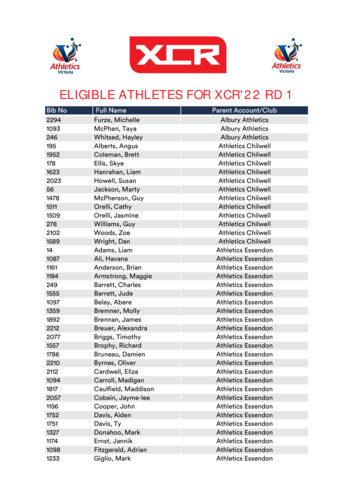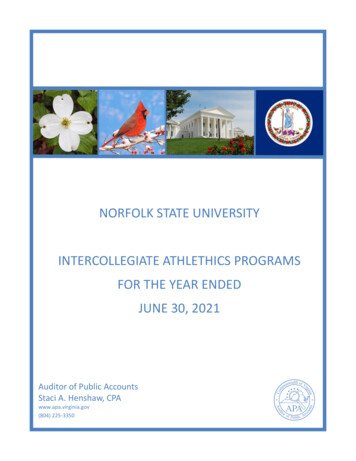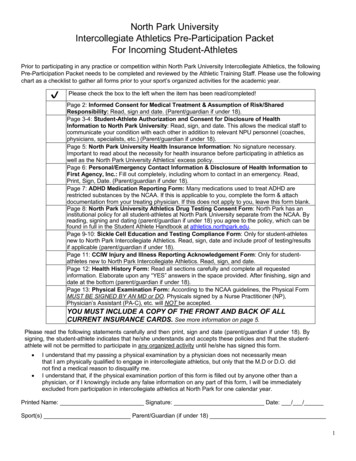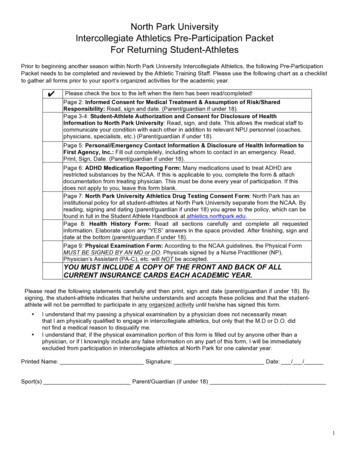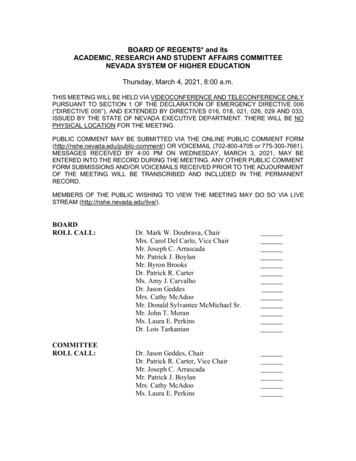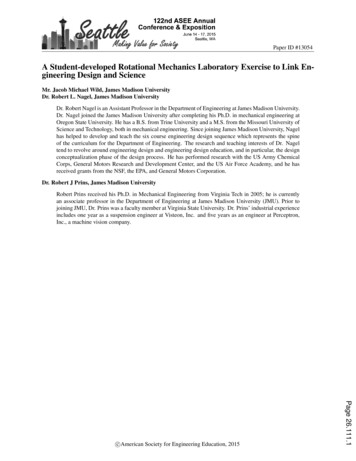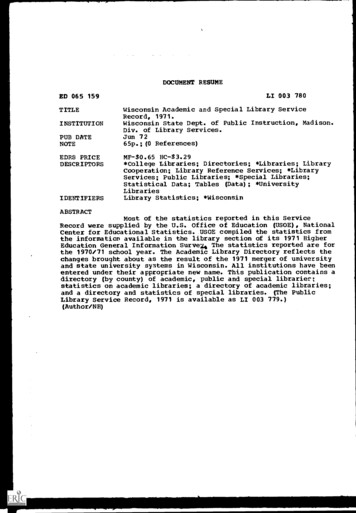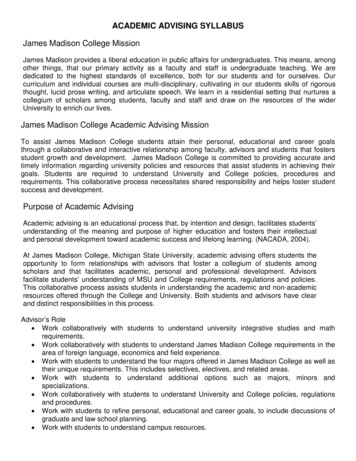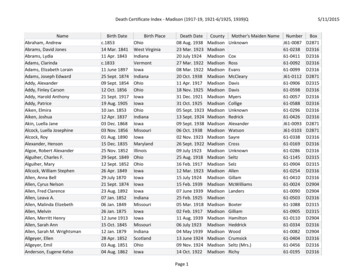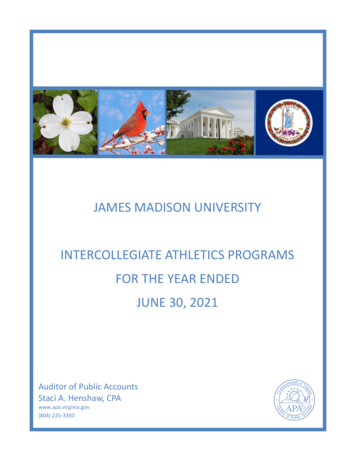
Transcription
JAMES MADISON UNIVERSITYINTERCOLLEGIATE ATHLETICS PROGRAMSFOR THE YEAR ENDEDJUNE 30, 2021Auditor of Public AccountsStaci A. Henshaw, CPAwww.apa.virginia.gov(804) 225-3350
–TABLE OF CONTENTS–PagesINDEPENDENT ACCOUNTANT’S REPORT ON APPLYINGAGREED-UPON PROCEDURES1-6SCHEDULESchedule of Revenues and Expenses of Intercollegiate Athletics ProgramsNotes to the Schedule of Revenues and Expenses of IntercollegiateAthletics ProgramsUNIVERSITY OFFICIALS78-1213
January 24, 2022The Honorable Glenn YoungkinGovernor of VirginiaJoint Legislative Auditand Review CommissionJonathan R. AlgerPresident, James Madison UniversityINDEPENDENT ACCOUNTANT’S REPORTON APPLYING AGREED-UPON PROCEDURESWe have performed the procedures enumerated below on the James Madison University’sSchedule of Revenues and Expenses of Intercollegiate Athletics Programs (Schedule) for the year endedJune 30, 2021. University management is responsible for the Schedule and its compliance with NationalCollegiate Athletic Association (NCAA) requirements.University management has agreed to and acknowledged that the procedures performed areappropriate to meet the intended purpose of evaluating whether the Schedule is in compliance withNCAA Constitution 3.2.4.17.1, for the year ended June 30, 2021. This report may not be suitable for anyother purpose. The procedures performed may not address all the items of interest to a user of thisreport and may not meet the needs of all users of this report and, as such, users are responsible fordetermining whether the procedures performed are appropriate for their purposes.Agreed-Upon Procedures Related to theSchedule of Revenues and Expenses of Intercollegiate Athletics ProgramsProcedures described below were limited to material items. For the purpose of this report, andas defined in the agreed-upon procedures, items are considered material if they exceed four percent oftotal revenues or total expenses, as applicable. The procedures and associated findings are as follows:Internal Controls1.We reviewed the relationship of internal control over intercollegiate athletics programsto internal control reviewed in connection with our audit of the university’s financialstatements. In addition, we identified and reviewed those controls unique to theIntercollegiate Athletics Department, which were not reviewed in connection with ouraudit of the university’s financial statements.Fiscal Year 20211
2.Intercollegiate Athletics Department management provided a current organizationalchart. We also made certain inquiries of management regarding control consciousness,the use of internal audit in the department, competence of personnel, protection ofrecords and equipment, and controls regarding information systems with the InformationTechnology Department.3.Intercollegiate Athletics Department management provided us with their process forgathering information on the nature and extent of affiliated and outside organizationalactivity for or on behalf of the university’s intercollegiate athletics programs. We testedthese procedures as noted below.Affiliated and Outside Organizations4.Intercollegiate Athletics Department management identified all related affiliated andoutside organizations and provided us with copies of audited financial statements foreach such organization for the reporting period.5.Intercollegiate Athletics Department management prepared and provided to us asummary of revenues and expenses for or on behalf of the university’s intercollegiateathletics programs by affiliated and outside organizations included in the Schedule.6.Intercollegiate Athletics Department management provided to us any additional reportsregarding internal control matters identified during the audits of affiliated and outsideorganizations performed by independent public accountants. We were not made awareof any internal control findings.Schedule of Revenues and Expenses of Intercollegiate Athletics Programs7.Intercollegiate Athletics Department management provided to us the Schedule ofRevenues and Expenses of Intercollegiate Athletics Programs for the year endedJune 30, 2021, as prepared by the university, and shown in this report. We recalculatedthe addition of the amounts in the Schedule, traced the amounts on the Schedule tomanagement’s trial balance worksheets, and agreed the amounts in management’s trialbalance worksheets to the Intercollegiate Athletics department’s accounts in theaccounting records. Certain adjustments to the Schedule were necessary to conform toNCAA reporting guidance. We discussed the nature of adjusting journal entries withmanagement and are satisfied that the adjustments are appropriate.8.We compared each major revenue and expense account over ten percent of totalrevenues or total expenses, respectively, to prior period amounts and budget estimates.We found no variances exceeding ten percent of prior period amounts or budgetestimates.Fiscal Year 20212
Revenues9.We obtained the amount of ticket sales revenue from the Schedule. The amount wasdeemed to be immaterial for detailed testing.10.We obtained documentation of the university’s methodology for allocating student feesto intercollegiate athletics programs. We compared student fees reported in theSchedule to amounts reported in the accounting records and an expected amount basedon fee rates and enrollment. We found the accounting records agree with the Schedule,and amounts transferred to the Intercollegiate Athletics Department and reported in theSchedule do not exceed expected amounts based on enrollment.11.We obtained the amount of direct institutional support revenue from the Schedule. Theamount was deemed to be immaterial for detailed testing.12.We obtained the amount of game guarantee revenue from the Schedule. The amountwas deemed to be immaterial for detailed testing.13.Intercollegiate Athletics Department management provided us with a listing of allcontributions of moneys, goods or services received directly by its intercollegiate athleticsprograms from any affiliated or outside organization, agency or group of individuals thatconstitutes ten percent or more of all contributions received during the reporting period.Except for contributions received from the James Madison University Foundation, Inc., anaffiliated organization, we noted no individual contribution which constituted more thanten percent of total contributions received for intercollegiate athletics programs. Wereviewed contributions from the James Madison University Foundation, Inc., whichexceeded ten percent of all contributions and agreed them to supporting documentation.14.We obtained the amount of in-kind revenue from the Schedule. The amount was deemedto be immaterial for detailed testing.15.We obtained the amount of media rights revenue from the Schedule. The amount wasdeemed to be immaterial for detailed testing.16.We obtained the amount of NCAA and conference distribution revenue from theSchedule. The amounts were deemed to be immaterial for detailed testing.17.We obtained the amount of royalties, licensing, advertisement, and sponsorships revenuefrom the Schedule. The amount was deemed to be immaterial for detailed testing.18.We obtained the amount of other operating revenue from the Schedule. The amountwas deemed to be immaterial for detailed testing.Fiscal Year 20213
Expenses19.Intercollegiate Athletics Department management provided us a listing of student aidrecipients during the reporting period. Since the university used the NCAA ComplianceAssistant software to prepare athletic aid detail, we selected 10 percent of individualstudent-athletes across all sports and obtained the students’ account detail from theuniversity’s student information system. We agreed each student’s information to theinformation reported in the NCAA Membership Financial Reporting System viaCompliance Assistant. We also ensured that the total aid amount for each sport agreedto amounts reported as financial aid in the student accounting system. We performed acheck of selected students’ information as reported in the NCAA’s Compliance AssistantSoftware to ensure proper calculation of revenue distribution equivalencies.20.We obtained the amount of game guarantee expense from the Schedule. The amountwas deemed to be immaterial for detailed testing.21.Intercollegiate Athletics Department management provided us with a listing of coaches,support staff, and administrative personnel employed and paid by the university duringthe reporting period. We selected and tested individuals, including football and men’sand women’s basketball coaches, and compared amounts paid during the fiscal year fromthe payroll accounting system to their contract or other employment agreementdocument. We found that recorded expenses equaled amounts paid as salary andbonuses and agreed with approved contracts or other documentation.22.We obtained a listing of debt service payments for athletic facilities for the reporting year.We reviewed all debt service payments and agreed them to supporting documentation.23.We selected a sample of disbursements for direct overhead and administration. Wecompared and agreed the selected operating expenses to adequate supportingdocumentation. We found all reviewed amounts to be properly approved, reasonable tointercollegiate athletics, and properly recorded in the accounting records.24.We obtained an understanding of the University’s methodology for charging indirect costto the athletic department. We evaluated indirect cost charges for reasonableness andnoted proper reporting of these charges in the Schedule.Other Reporting Items25.We obtained repayment schedules for all outstanding intercollegiate athletics debt duringthe reporting period. We recalculated annual maturities reported in the notes to theSchedule and agreed total annual maturities and total outstanding athletic-related debtto supporting documentation.Fiscal Year 20214
26.We agreed total outstanding institutional debt to supporting debt schedules and theuniversity’s unaudited financial statements and general ledger, as the audited financialstatements were not yet available.27.We agreed the fair value of athletics-dedicated endowments to supportingdocumentation provided by the James Madison University Foundation, Inc.28.We agreed the fair value of institutional endowments to supporting documentationprovided by the James Madison University Foundation, Inc.29.We obtained a schedule of athletics related capital expenditures made during the period.We reviewed all capitalizable equipment transactions to validate existence and accuracyof the recording and recalculated totals.Additional Procedures30.We compared the sports sponsored by the university, as reported in the NCAAMembership Financial Reporting System, to the Calculation of Revenue DistributionEquivalencies Report (CRDE) from the NCAA’s Compliance Assistant software for theinstitution. We noted agreement of the sports reported.31.We compared total current year grants-in-aid revenue distribution equivalencies to totalprior year reported equivalencies per the NCAA Membership Financial Report submissionand noted no variations exceeding four percent when compared to prior year.32.We obtained the university’s Sports Sponsorship and Demographics Forms Report for thereporting year. We validated that the countable sports identified by the institution metthe minimum requirements for number of contests and minimum number of participantsas defined in NCAA Bylaw 20.9.6.3 or qualified for the extraordinary blanket waiver perNCAA guidance due to the COVID-19 pandemic. We ensured that countable sports havebeen properly identified in the NCAA Membership Financial Reporting System for thepurpose of revenue distribution calculations.33.We compared the current number of sports sponsored to the prior year total reported inthe university’s NCAA Membership Financial Report submission and noted no variationswhen compared to prior year.34.We obtained a listing of student-athletes receiving Pell grant awards from the university’sstudent information system and agreed the total value of these Pell grants to the amountreported in the NCAA Membership Financial Reporting System. We noted agreement ofthe amounts reported.Fiscal Year 20215
35.We compared the total number of Pell grant awards in the current year to the numberreported in the prior year NCAA Membership Financial Report submission. We noted novariations greater than 20 grants when compared with the prior year.We were engaged by university management to perform this agreed-upon proceduresengagement and conducted our engagement in accordance with attestation standards established bythe American Institute of Certified Public Accountants. We were not engaged to and did not conduct anaudit, examination, or review engagement, the objective of which would be the expression of an opinionor conclusion, respectively, on the Schedule of Revenues and Expenses of Intercollegiate AthleticsPrograms or any of the accounts or items referred to above. Accordingly, we do not express such anopinion or conclusion. Had we performed additional procedures, other matters might have come to ourattention that would have been reported to you.We are required to be independent of the university and to meet our other ethicalresponsibilities, in accordance with the relevant ethical requirements related to our agreed-uponprocedures engagement.This report is intended solely for the information and use of James Madison University and itsPresident and is not intended to be and should not be used by anyone other than these specified parties.However, this report is a matter of public record and its distribution is not limited.Staci A. HenshawAUDITOR OF PUBLIC ACCOUNTSJRQ/cljFiscal Year 20216
JAMES MADISON UNIVERSITYSCHEDULE OF REVENUES AND EXPENSES OFINTERCOLLEGIATE ATHLETICS PROGRAMSFor the year ended June 30, 2021Men'sBasketballFootballOperating revenues:Ticket sales Student feesDirect institutional supportGuaranteesContributionsIn-KindMedia rightsNCAA distributionsConference distributions (non-media and non-football bowl)Royalties, licensing, advertisement and sponsorshipsOther operating revenueTotal operating revenuesOperating expenses:Athletic student aidGuaranteesCoaching salaries, benefits, and bonuses paid by theUniversity and related entitiesSupport staff/administrative compensation, benefits, andbonuses paid by the University and related entitiesSeverance paymentsRecruitingTeam travelSports equipment, uniforms, and suppliesGame expensesFundraising, marketing and promotionSpirit groupsAthletic facility leases and rental feesAthletic facility debt serviceDirect overhead and administrative expensesIndirect cost paid to the institution by athleticsMedical expenses and insuranceMemberships and duesStudent-Athlete meals (non-travel)Other operating expensesTotal operating expensesExcess (deficiency) of revenues over (under) 03626 asketball 4,442216,0325,89624,0804,5734,617-Non-ProgramOther SportsSpecific 75,08714,160180,817103,995166,76615,3006,970 001,732,65281,932Total 552,865,352 (7,219,960) (2,990,485) (2,312,467) (11,739,492) 24,262,404Other Reporting Items:Total athletics-related debtTotal institutional debtValue of athletics-dedicated endowmentsValue of institutional endowmentsTotal athletics-related capital expenditures - 113,379,050 413,814,327 11,483,349 143,206,127 10,643,282The a ccompa nyi ng Notes to the Schedul e of Revenues a nd Expens es of Intercol l egi a te Athl eti cs Progra ms a re a n i ntegra l pa rt of thi s Schedul e.Fiscal Year 20217
JAMES MADISON UNIVERSITYNOTES TO SCHEDULE OF REVENUES AND EXPENSES OFINTERCOLLEGIATE ATHLETICS PROGRAMSFOR THE YEAR ENDED JUNE 30, 20211.BASIS OF PRESENTATIONThe accompanying Schedule of Revenues and Expenses for the university’s AthleticDepartment has been prepared on the accrual basis of accounting, with the exception of debtservice payments and depreciation. Principal and interest payments made on long-term debtrelated to athletic facilities are included in expenses on the cash basis (see Note 4). In theuniversity’s financial statements, depreciation expense is not included at the program level, andtherefore is not allocated to athletics in the accompanying Schedule. See Note 3 for furtherinformation on athletics related capital assets.The Schedule’s purpose is to present a summary of revenues and expenses related to theuniversity’s intercollegiate athletics programs for the year ended June 30, 2021. The Scheduleincludes both those revenues and expenses for athletic programs under the direct accountingcontrol of the university and those on behalf of the university’s athletics programs by outsideorganizations not under the university’s accounting control. Because the Schedule presents onlya selected portion of the university’s activities, it is not intended to and does not present eitherthe net assets, changes in net assets, or changes in cash flow for the year then ended.Sports Accounting – Because of the significant revenues and expenses generated byfootball, men’s basketball, and women’s basketball, they are reported separately. Other sportsin which the university participates are combined and reported as “Other Sports.” AthleticDepartment administrative functions and activities that provide support for all sports have beencombined for reporting purposes under the caption “Non-Program Specific.” These supportactivities include costs such as those related to facilities maintenance, fundraising/promotions,sports medicine, academic counseling, administration, communications, ticket office,compliance, etc.Student Fees – The university assesses each student a comprehensive fee that covers avariety of auxiliary programs, such as student activities, student health, transportation, athletics,and auxiliary related debt service. The comprehensive fee is distributed near year-end based onbudgeted amounts. For the Schedule of Revenues and Expenses of Intercollegiate AthleticsPrograms, student fees are allocated to cover any overall athletic operating deficit. Conversely,if revenues exceed expenses, student fees allocated are reduced since any excess does notremain with the athletic department but instead increases the University’s general auxiliaryreserve.Direct Institutional Support – The University funds various auxiliary renovation andmaintenance projects or enhances auxiliary operating budgets from the general auxiliary reserve.Fiscal Year 20218
Athletic-related project expenses that are not capitalized and non-recurring operatingenhancements are recorded in the applicable expense categories, with an offsetting amountrecognized as direct institutional support revenue.2.COMPONENT UNITThe James Madison University Foundation, Inc. is included as a component unit in theuniversity’s financial statements. The foundation was formed to promote the achievements andfurther the aims and purposes of the university. The foundation accomplishes its purposesthrough fundraising and funds management efforts that benefit the university and its programs.Donations to the foundation earmarked for athletics operations or capital projects are notincluded in the Schedule, nor is endowment financial activity related to athletics. Foundationexpenses made on behalf of the athletics programs are included in the Schedule. Expenses madein support of athletics totaling 2,339,955 are included in revenue as “contributions” andincluded in various operating expense lines.3.CAPITAL ASSETSThe university’s policies and procedures for acquiring, approving, depreciating, anddisposing of athletic–related capital assets is the same as for all university capital assets.Capital assets include buildings and other improvements, equipment, and infrastructureassets such as sidewalks, steam tunnels, and electrical and computer network cabling systems.Capital assets are generally defined by the university as assets with an initial cost of 5,000 ormore and an estimated useful life in excess of two years. Such assets are recorded at actual costor estimated historical cost if purchased or constructed. Donated capital assets are recorded atthe estimated fair market value at the date of donation. Expenses for major capital assets andimprovements are capitalized (construction-in-progress) as projects are constructed. Interestexpense relating to construction is capitalized net of interest income earned on resources setaside for this purpose. The costs of normal maintenance and repairs that do not add to an asset’svalue or materially extend its useful life are not capitalized. Certain maintenance andreplacement reserves have been established to fund costs relating to residences and otherauxiliary activities.Depreciation is computed using the straight-line method over the estimated useful life ofthe asset and is not allocated to the functional expense categories, and therefore depreciation isnot included in the Schedule of Revenues and Expenses of Intercollegiate Athletics Programs.Useful lives by asset categories are listed below:BuildingsOther improvements and infrastructureEquipment25-50 years20 years5-15 yearsFiscal Year 20219
A summary of athletic-related capital assets for the year ending June 30, 2021, is presented asfollows:BeginningEndingBalanceNon-depreciable capital assets:Construction in progress** 84,717,808Additions 652,847Reductions Balance(84,501,407) 869,248Depreciable capital assets:Buildings and other 303)(97,223)234,786,21215,586,37811,940,638Total depreciable capital 5,59369,700,0447,642,164(2,955,673)74,386,535 182,136,028 92,616,183Less accumulated depreciation for:Buildings and other improvements*InfrastructureEquipmentTotal accumulated depreciationTotal capital assets, Net (85,956,270) 188,795,941*Beginning balance adjusted by 546,085 for understatement of FY20 capital assets and by 6,501 for understatement of accumulateddepreciation for FY20 Building Renovation asset 0057D not included in FY20 footnotes**Beginning balance adjusted by 229,263 for understatement of FY20 non-depreciable capital assets (CIP).4.LONG-TERM DEBTFor debt related to the Intercollegiate Athletic Department, the university has issuedSection 9(d) bonds pursuant to Article X of the Constitution of Virginia. These bonds are revenuebonds, which are limited obligations of the university payable exclusively from pledged generalrevenues and are not debt of the Commonwealth of Virginia, legally, morally, or otherwise.Pledged general fund revenues include general fund appropriations, tuition and fees, auxiliaryenterprise revenues, and other revenues not required by law to be used for another purpose.The university participates in the Public Higher Education Financing Program (Pooled BondProgram) created by the Virginia General Assembly in 1996. Through the Pooled Bond Program,the Virginia College Building Authority (VCBA) issues 9(d) bonds and uses the proceeds topurchase debt obligations (notes) of the university and various other institutions of highereducation. The university’s general revenue also secures these notes.Fiscal Year 202110
DescriptionVeteran's Memorial ParkBridgeforth StadiumUniversity Park*Atlantic Union Bank CenterTotalInterest 2030203120322049Balance atJune 30, 2021 4,850,00024,705,00013,564,05070,260,000 113,379,050* Multiple debt issues were issued for both athletic and recreation facilities.Debt listed above represents only the portion of debt allocated to athletics.Long-term debt matures as -2049Total:5. 80033,054,15054,442,300 3,37224,660,044 113,379,050 61,902,883EXPENSE CATEGORIESSpirit Groups – The spirit group category consists of all expenses related to the JMU MarchingBand and Cheerleaders, including student aid and salaries/wages.Indirect cost paid to the institution by athletics – The Commonwealth’s Appropriation Act(Chapter 1289 for the 2021-2022 biennium) requires that educational and general programs ininstitutions of higher education recover the full indirect cost of auxiliary enterprise programs.The University assesses each auxiliary unit an indirect charge to recover institutional educationaland general administrative overhead costs. In fiscal year 2021, this charge to the athleticsdepartment amounted to 4,558,735.Other expenses - Expenses in this category include communication services, supplies, noncapitalized equipment/rentals, employee training and development, moving and relocation, andtravel (other than team travel).6.EQUITY IN DISCLOSURE ACT (EADA) REPORTINGThe university annually prepares the EADA Survey that reports on athletic participation,staffing, and revenue and expenses, categorized by men’s and women’s teams. The Survey isFiscal Year 202111
submitted to the federal Department of Education’s Office of Postsecondary Education and isavailable at the following web address: http://ope.ed.gov/athletics.It is the university’s policy that revenue and expenses reported in the EADA Survey willequal the NCAA Schedule of Revenues and Expenses of Intercollegiate Athletics Programsbalances, with the exception of debt service. The EADA Survey requires that preparers excludedebt service from athletic-related expenses.Fiscal Year 202112
JAMES MADISON UNIVERSITYAs of June 30, 2021BOARD OF VISITORSLara P. MajorRectorDeborah T. JohnsonVice RectorVanessa M. Evans-GreviousLucy HutchinsonChristopher FalconMaria D. JankowskiHerHeroHerHerHutchinsonFrank GadamsJohn LynchJeffrey E. GrassMaggie RagonMatthew Gray-KeelingJohn C. RothenbergerMaribeth HerodKathy WardenCraig B. WelburnUNIVERSITY OFFICIALSJonathan AlgerPresidentJeffrey BourneDirector of Intercollegiate Athletic ProgramsCharles W. King, Jr.Senior Vice President for Administration and FinanceMark AngelAssistant Vice President for Administration and FinanceFiscal Year 202113
We have performed the procedures enumerated below on the James Madison University's Schedule of Revenues and Expenses of Intercollegiate Athletics Programs (Schedule) for the year ended June 30, 2021. University management is responsible for the Schedule and its compliance with National Collegiate Athletic Association (NCAA) requirements.
